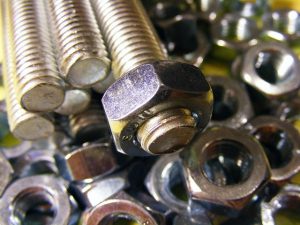
Machines are often held together with fasteners, one of the most common types being machine screws. From engines and appliances to industrial lathes and milling machines, countless machines contain machine screws. These otherwise simple fasteners join two or more parts. For a better understanding of machine screws and how they work, keep reading.
What Is a Machine Screw?
A machine screw is a type of threaded fastener that’s designed for use in a machine. It’s driven into a pre-cut hole where it holds a machine’s parts together. Machine screws consist of a head, followed by a fully threaded shank. The shank has exterior threading that allows the machine screw to be driven into a tapped hole with interior threading.
Because they are used in machines, machine screws must be designed to withstand vibrations and liquids. If a machine screw is made of a weak material, it may crack when exposed to a machine’s vibrations. Machines often vibrate, and these vibrations can crack weak fasteners. Alternatively, low-quality machine screws may rust or corrode when exposed to moisture.
You can find machine screws available in many materials, including the following:
- Titanium
- Stainless steel
- High-carbon steel
- Bronze
- Brass
- Aluminum alloy
- Nickel-copper alloy
Machine Screws vs Bolts: What’s the Difference
Machine screws may look like bolts, but they aren’t necessarily the same. Machine screws have a slotted head, whereas bolts have a hex head. With a slotted head, machine screws can be installed using a screwdriver, such as a Philips head or flat-heat screwdriver. You can install a machine screw by placing a screwdriver into the slotted head and turning it. Conversely, you can remove a machine screw by turning the screwdriver in the opposite direction (counter-clockwise).
In comparison, bolts typically require the use of a hex socket to install. They don’t feature a slotted head. Instead, bolts have a hex head that only works with a hex socket. To install a bolt, you must place a hex socket over the bolt’s head and then turn it.
Another difference between machine screws and bolts lies in their respective size. Most machine screws are relatively small compared to other fasters like bolts. Bolts are available in a variety of sizes, with some of them being over 2 inches long. Machine screws, on the other hand, are usually less than 1 inch long. You can still find longer machine screws, but they typically come in smaller sizes than bolts.
